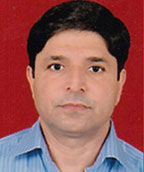
(Director)
The Thar Desert of Rajasthan is known as Great Indian Desert is one of the most generic ecosystems in the world. It is distinguish from other deserts of the world having several manifestations embodies their uniqueness and distinguishedness. Thar Desert research center which was established in the year 2017 having so many challenges in various thrust area of this environment. The centre shall provide an opportunity to people from all sections of the society for better development in all aspects of life. Center has identified thrust areas that are of utmost importance for the holistic development of the people of Thar Desert, namely, ecology and environment, flora and fauna, climate, geography, natural resources, society, culture and religion, heritage, craft and cottages, health & education, traditional practices, agrarian economy, livelihood, impact of canals and modern agricultural practices etc. This shall be executed through studies, research and projects, seminars, symposiums, workshops, publications, policy analysis, etc. The Center will collaborate with various institutions and companies, possibly through educational and corporate houses. Our belief that people should be the custodian of environment and social heritage received unparallelly support from all sections of society.
To build responsive, sensitive, creative and thoughtful citizens in the region, with a comprehensive understanding of regional, national and international perspectives.
To strive towards the educational, cultural, economic, environmental and social advancement of the region and the nation at large, by providing excellent liberal education and quality programs to ensure sustainable development in the region.
The Centre was established with following objectives:
| S.No. | Heads | Cost &(in rupees) | Justification |
| 1 | Workshops/ National Seminars | 2 Lacs | Workshops/Seminar/Conference is integral part and regular research activities. It helps to generate awareness |
| 2 | Books(FieldGuides/Flora/Fuana/Reference) | 3 Lacs | Reference books, encyclopedia, flora of desert, biodiversity of Thar etc are important material for students/research and faculty member. |
| 3 | GPS, DSLR Camera, Lenses, Laptops | 5 Lacs | GPS, Camera(DSLR), Lances for camera, Laptops are required to collection, interpretation and storage of data for making effective presentation, tools |
| 4 | Herbarium | 3 Lacs | For keeping original plant s |
| 5 | vehicle with portable field equipments | 20 Lacs | Vehicle is very necessary to collect sample from different parts of the Desert. It will be equipped with various field instruments, which are required for data collection. |
| 6 | Printers Cartridges, Data Storage devices etc | 2 Lacs | Required for official work. |
| 7 | Miscellaneous | 2 Lacs | To meet the sundry requirements of the center this fund is required to meet the needs. |
| TOTAL | 37 Lacs |